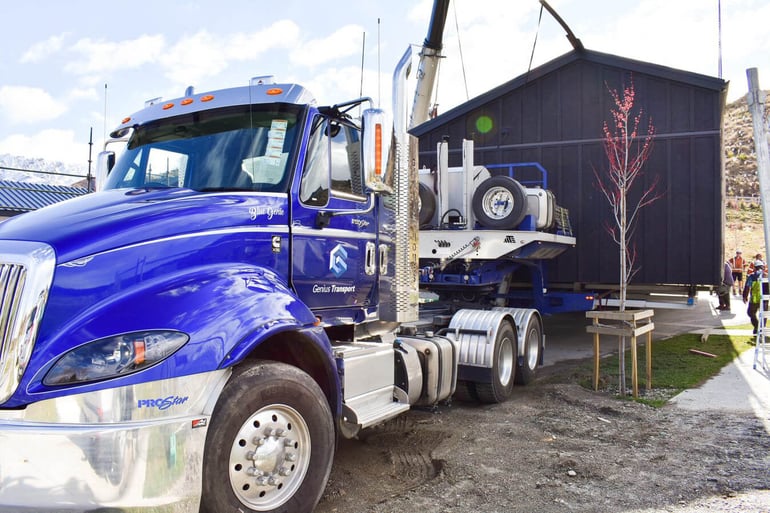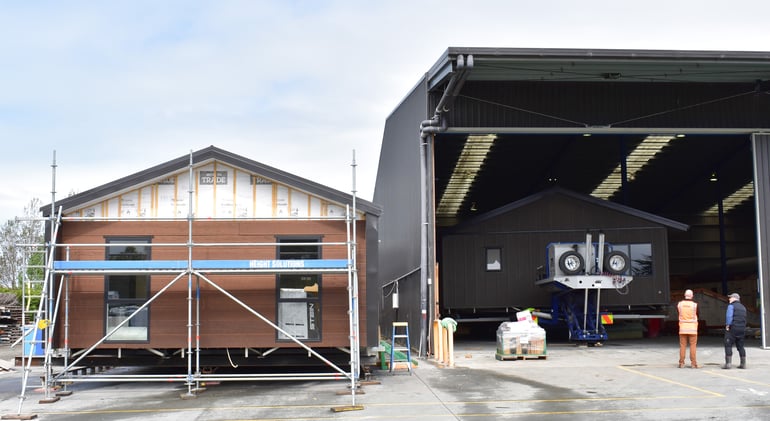Are prefabs the cheapest way to get property in 2022?
Buying a house is no small purchase and there are many factors to take into consideration when exploring how to get property in the most affordable way possible. House prices are continuing to climb and with the treasury predicting house prices to increase by more than 10% in 2022 the market shows no sign of changing. If you’re searching for ways to enter the property market, or even simply to upsize or downsize your existing home, it’s important you weigh up all your options. Exploring different avenues and doing your research is an important step if you’re wanting affordable housing in 2022. A good place to start is weighing up whether to build or buy a new home.
Is it better to buy or build?
To answer this, you’ll need to consider not only your budget but your lifestyle and current circumstances as well. Buying an existing home is a simpler process, with overwhelmingly fewer decisions to make and less uncharted territory to navigate, especially for those new to the game. The turnaround time to move-in is often a much quicker process than building, which in the current climate could take anywhere from 6-18 months. And, if you’re after a home in a sought-after location, the potential to purchase property near central hubs is a lot higher when seeking an existing home. Fast-track to life in a bustling community by buying, or be willing to hunt out more distant suburbs where land to build on is more readily available.
When it comes to the cold hard price, however, the median nationwide house price, according to REINZ’s November 2021 report, is $925,000. With this number seeing a 27.2% year-on-year increase from 2020 that’s quite a large price increase in such a short space of time. When we exclude Auckland, the median house price across the country is $775,000. Across the South Island, these prices vary considerably.
South Island median house prices*
- Otago $720,000
- Canterbury $690,000
- Southland $435,000
- West Coast $350,000
- Marlborough $705,000
- Nelson $736,000
- Tasman $890,000
*Median house price data was taken from November 2021 according to REINZ
While there’s no denying the cost of buying a house in New Zealand is high and is rapidly on the rise, the cost of building is also steadily increasing. As of November 2021, the average price of a new build is $381,404, not including land. For the South Island, that price is $376,168. We break this down by region, below.
Region Average Price*
-
- Otago $461,916
- Nelson $402,834
- Tasman $416,237
- Canterbury $342,635
- Southland $407,581
- West Coast $333,297
* Average costs are estimates based on building consent applications and excludes fees and land prices. This data was taken from the November 2021 report by Canstar.
It’s important to note that toward the end of 2021 we saw a spike in material costs due to COVID-19 related supply issues, delays, and shortages that are not likely to be reflected in these prices. Material prices are projected to continue to rise, which coincidentally means the cost of building will rise with it. In this age of augmenting prices, Genius Homes remains one of the few building companies to still offer fixed-price contracts on their homes. With a fixed-price contract, you’re able to lock in the price early in the process, meaning, even if material costs spike further in the months leading up to your home being finished, your final price is guaranteed to stay the same.
The consensus? Deciding whether building or buying is your cheapest option, really depends on what you’re after! Maybe you’re happy with a doer-upper and getting on the property ladder soon with a lower upfront cost and plans to tap into your inner DIY fanatic further down the track as finance allows. In which case, initially, buying an existing property would suit you.
But maybe you’re in need of a low maintenance, good quality home from the get-go, in which case, it’s likely that building will be better value for money. Whether you’re after a home customised to you, you’ve already got land available, or you want the experience of a new home, there are loads of reasons building new is the better financial decision.
 As a first home buyer, it’s worth doing your due diligence and seeking government grants to assist. It’s likely you’ll be eligible for a $20,000 first home grant when building new. That’s double the value granted if merely buying an existing property. However, many of these grants have not been updated to reflect the increasing real-world prices, so check if you fall above the thresholds before committing based on this assistance.
As a first home buyer, it’s worth doing your due diligence and seeking government grants to assist. It’s likely you’ll be eligible for a $20,000 first home grant when building new. That’s double the value granted if merely buying an existing property. However, many of these grants have not been updated to reflect the increasing real-world prices, so check if you fall above the thresholds before committing based on this assistance.
If it’s an investment property you’re after, building new could also be more financially beneficial as new builds only require a 20% deposit rather than the 40% deposit required when buying an existing home. New build investment properties benefit from a lower Bright Line test limit than an existing property, which is something to bear in mind if you are considering selling the home in the next 5-10 years. With these government initiatives encouraging building new, there are many ways building new can end up being the better financial decision. Not to mention there’s also a higher potential for yielding instant equity on your home when building new! So do your research, reach out to your bank or mortgage broker, or chat with our team to find out what financing options are available for you and your situation.
Are prefabs the cheapest way to build?
If building is the best option for you, you’ll need to explore your building options. If affordability without compromising on quality is what you’re after, you’ve come to the right place!
The concept of prefab homes originated from a desire to redesign the build process to be more sustainable, more affordable, and much quicker than a traditional build. Being factory-built cuts wasted time, wasted materials, and therefore wasted money from the equation meaning, in short, a newly built prefab home is going to be significantly cheaper than an equivalently-sized standard new build.
Instead of trekking materials to each site, commuting tradespeople, and building homes one at a time, prefabrication consolidates these elements. With prefab homes, costs are controlled, travel time is eliminated, and materials are readily available, meaning costs are naturally going to be reduced, thus saving you and the building company time and money. Not to mention, weather delays and potential for damage are reduced also.
 Prefabs save costs on materials through bulk purchasing and the factory build process helps drastically cut down on construction waste and debris, which can add up to an enormous cost in a traditional build. It’s not only a more efficient use of building materials and your money, but it’s a much more convenient and sustainable way to build. Making prefabs the most affordable way to build in 2022.
Prefabs save costs on materials through bulk purchasing and the factory build process helps drastically cut down on construction waste and debris, which can add up to an enormous cost in a traditional build. It’s not only a more efficient use of building materials and your money, but it’s a much more convenient and sustainable way to build. Making prefabs the most affordable way to build in 2022.
When is a prefab not the cheapest option?
While buying a prefab could just be the cheapest way to get property in the current housing climate, there are factors that could push up the cost of your new prefab and therefore should be considered. The biggest additional cost, for example, would be location. Prefab homes require delivery and this cost is not included in the house price. This cost can range from $9,902 up to $140,588, with the average cost being $48,530. The closer your site is to the factory, the easier it is to access, and the smaller the home the lower this cost will be. Genius Homes delivers to most of the South Island, and most commonly to Otago, Canterbury, and Southland. It’s possible to deliver to the West Coast, or Nelson regions, but expect to pay a little more for these regions. And while our delivery team are undeniably experts in their field, even they can’t manoeuvre their way through to every nook and cranny of our beautiful country so unfortunately, areas such as Tasman requiring access over the narrow and windy Takaka Hill are off the cards.
Find out more about where Genius Homes’ delivers here ›
Like most building companies, our prefab range of homes spans farm homes to luxury dwellings, so if you’ve got a tight budget and are keen on keeping costs down, opt for something on the more humble end of the scale, and be willing to compromise on upgrades for now. It’s a great place to start, and depending on what you’re after it could be the perfect solution to meeting your current needs.
All Genius Homes prefabs come with standard inclusions and the option to upgrade these should you wish. Any customisation costs and luxury upgrades will result in an upwards cost from the original price so if affordability is a top priority, be clear from the get-go on what you must have and what you can forgo to manage expenses. The more open you are about your priorities from the beginning, the easier it will be to make an informed decision about how much you’re happy to spend on your new home and enjoy peace of mind knowing exactly what this price will be.
Our prefab house designs at Genius Homes have enabled people to get into their first home, buy their second home, upgrade to a larger home, downsize to something simpler, and everything in between! With an extensive range of prefab house designs varying in size, style, and price you’re sure to find one that suits your new build needs and budget too. Get in touch with one of our friendly prefab experts to talk about your options. If you know what you’re after and want to quickly filter through our plans then why not try our dream home finder by clicking the link below?

